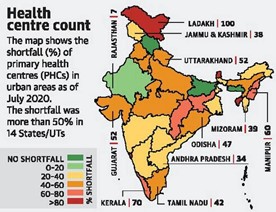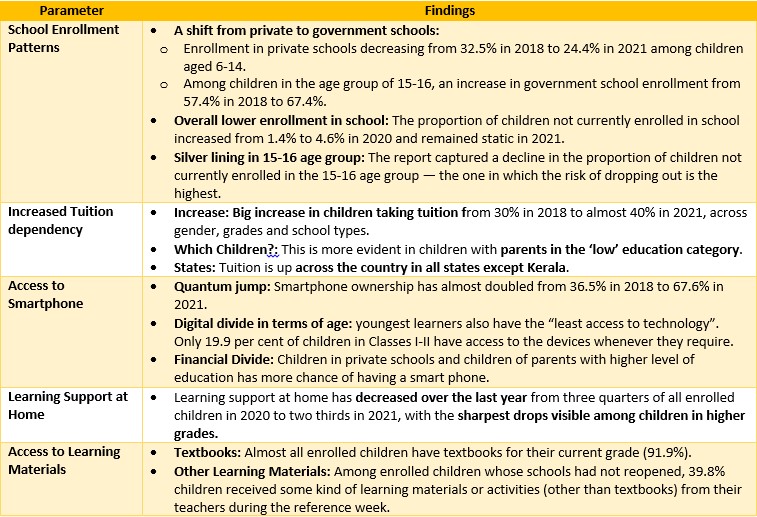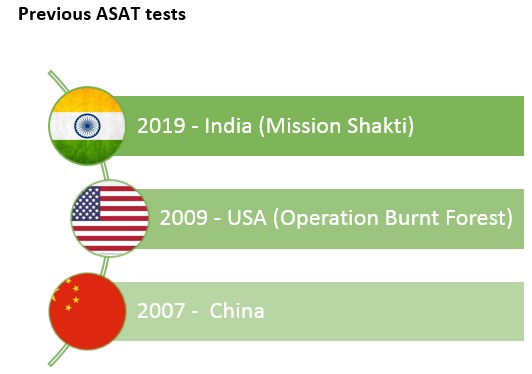Tuesday, 23rd November 2021
JPC recommendations on draft Personal Data Protection (PDP) Bill, 2019
In News
The joint parliamentary committee (JPC) reviewing the proposed data protection law finalized its report.
About the News
- The JPC was set up in 2019 to take up the personal data protection bill after parliamentarians were divided over several provisions of the law meant to give a legal shape to the Right to Privacy after it was made a fundamental right by the Supreme Court in 2017.
- The report will be tabled for discussion in the Parliament session beginning November 29, following which the government will reintroduce the bill. The recommendations are not binding.
Important Provisions of Personal Data Protection (PDP) Bill 2019
- Objective: The Bill seeks to provide for protection of personal data of individuals, and establishes a Data Protection Authority for the same.
- The PDPB proposes to protect "Personal Data" relating to the identity, characteristics trait, attribute of a natural person and "Sensitive Personal Data such as financial data, health data, etc.
What have been the concerns raised by the JPC?
- Data Localization: Some lawyers contend that security and government access are not achieved by localisation. Even if the data is stored in the country, the encryption keys may still be out of reach of national agencies.
- Threat of fractured and inefficient internet: Technology giants like Facebook and Google are concerned with a fractured Internet (or a “splinternet”) because of isolated pockets of data and protectionist policies being against competitive market.
- Exemption to Union Government agencies: Clause 35 in the name of “public order”, ‘sovereignty’, “friendly relations with foreign states” and “security of the state” allows any agency under the Union Government exemption from all or any provisions of the law.
- Against the exemption: It does not provide adequate safeguards to protect the right to privacy and gives an overboard exemption to the Government.
- There should be “judicial or parliamentary oversight” for granting such exemptions and “there should be an order in writing with reasons for exempting a certain agency from the ambit of the Bill”.
Recommendations of JPC on debates
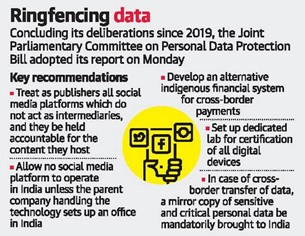
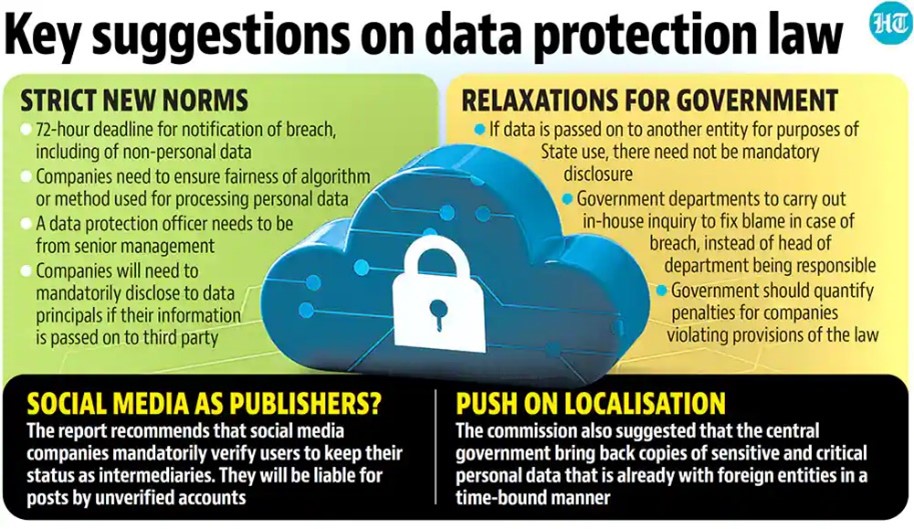
Source:
Growing Space Junk
In News
Research findings by University of Utah, US, suggest that today the space is filled with so much space debris that, using magnet technology, we may have to push it to form Saturn-like rings around our very own home planet.
About the News
- According to European Space Agency (ESA), there are 170 million fragments of floating space debris—including natural meteoroids, broken pieces of artificial objects, and defunct satellites—some fragments large enough (10 cm) even to hinder orbital missions and space flights.

- Space Debris: Space debris also known as space junk is defunct artificial objects in space which no longer serve a useful function. These include discarded and non-functional spacecraft, abandoned launch vehicle stages and mission-related debris.
- Debris can also be caused by an explosion in space or when countries conduct missile tests to destroy their own satellites by missiles. The Space debris are numerous particularly in Earth Lower orbit.
How can the Space debris form a ring around the Earth?
- Earth as a natural cleanser: Earth's atmosphere can naturally clean the debris. It pulls the artificial floating space junk fragments downward into its thick lower atmosphere, eventually burning up within a few years.
- However, the increasing carbon concentrations lead to reduced density of our planet's upper atmosphere, which may lessen this effect.
- New Mechanisms: The recent study aims to clear this mess by spinning magnets and creating magnetic fields that can manage space objects even if they are not magnetic.
- This method promises a new and innovative way to safeguard global space assets. So, one can say that Earth is on course to have its own rings, they’ll just be made of junk.

Why are Space Debris as a major concern?
- Space junk, has now been categorised as a type of pollution, has grown dramatically by about 7,500 metric tonnes in the past decades.
- While space debris is unlikely to affect space travel, it will lead to significant problems for spaceflight around Earth.
- The risk would be highest for objects orbiting at an altitude of around 1,000 kilometres (620 miles), which is used for communications and Earth observation.
- On November 15, post Russia’s ASAT Mission, seven astronauts of the International Space Station had to seek shelter in their transportation spacecraft, as a junk fragment was about to come crashing nearly at the speed of light. (refer for more information: https://edukemy.com/newsdailynews?newsitem=14464&date=1637087400)
Sources:
SBI Ecowrap report on agricultural reforms
In News: A research report from the State Bank of India’s Economic Research Department, SBI Ecowrap, has recently proposed 5 key agricultural reforms.
About the News
- These reforms have been proposed right after the recent decision to repeal the 3 new agricultural laws and the farmers’ demand for legal guarantee of MSP.
- The economists have suggested these reforms believing it to act as enablers even without the three Bills.
The Essential Reforms
- Quantity guarantee clause instead of MSP: The report states that Instead of MSP as a price guarantee that farmers are demanding, the Government may come up with a quantity guarantee clause for a minimum period of 5 years.
- This clause will make its mandatory procurement to production percentage of crops (being currently procured) at least equal to last year’s percentage (with safeguards in exceptional events like droughts, floods etc).
- Convert MSP to Floor Price of auction on e-NAM: Convert the Minimum Support Price to Floor Price of Auction on National Agriculture Market (eNAM). However, this will not completely solve the problem as the current data shows that average modal prices in e-NAM mandis are lower than the MSP in all Kharif commodities (except Soyabean).
- e NAM is a pan India electronic trading portal that networks the existing APMC mandis to create a unified market for agricultural commodities
- Strengthen APMC Markets: Efforts must also continue to strengthen APMC market infrastructure.
- APMC is the marketing board established by respective State Governments to eliminate the exploitation of farmers by intermediaries where they are forced to sell their produce at low prices.
- Establishing Contract Farming Institution: Establishing such an institution in India will give farmers the exclusive right to oversee price discovery in Contract Farming.
- Contract farming is an agreement between farmers and processing/marketing firms for the production of supply of agriculture products at predetermined prices.
- The basis of such an arrangement is a commitment on the part of the farmer to provide a specific commodity in quantities and at quality standards determined by the purchaser and a commitment on the part of the company to support the farmers production and to purchase the commodity.
- Symmetric Procurement across States: The procurement of cereals has been asymmetric, with top producing states in paddy like West Bengal (First) and Uttar Pradesh (Second) having witnessed minimal procurement while Punjab and Haryana despite not being the largest producers have been witnessing much larger procurement
Source:
Cocos Islands
On Novemeber 23, 1955, Britain transfered the Cocos (Keeling) Islands in the Indian Ocean to Australia. Cocos Islands, officially Territory of Cocos (Keeling) Islands, also called Keeling Islands, is an external territory of Australia in the eastern Indian Ocean. The isolated territory is made up of two coral atolls. The inhabitants are predominantly the descendants of the original plantation workers, mostly of Malay origin, who were brought to the islands. Most of the Cocos Malays speak a dialect of Malay and are Muslim. The production and export of copra is the territory’s economic mainstay. An administrator appointed by the Australian governor-general is the senior governmental official in the Cocos.

Source:
Ecological Threat Report, 2021
In News
The second edition of the Ecological Threat Report, 2021 was recently released by the international think tank, the Institute of Economics and Peace (IEP).
About the Ecological Threat Report
- The Ecological Threat Report (ETR) is a comprehensive, data-driven analysis of 99.9 per cent of the world's population and assesses threats relating to food risk, water risk, population pressures, climate change and natural disasters.
- The five threats included in the ETR can be clustered into two major domains:
- The Resource Scarcity domain measures the threat from food risk, water risk and population growth.
- The Natural Disaster and Temperature Change domain measures the threat from floods, droughts, cyclones, earthquakes, volcanoes, extreme temperature events, significant storms, and rising temperatures.
Why is World’s Ecology under threat?
- The balance between human activity and the planet's ecology is coming under increasing stress. Globally, 2.6 billion people are exposed to high and extreme water stress.
- The number of natural disasters has tripled over the last four decades and is likely to continue growing.
- With the global population continuing to increase, consumption will grow, thereby increasing humanity's ecological footprint. As a result, the effects of ecological threats will become more pronounced.
- Food insecurity has slowly become more prevalent and approximately one in three people globally do not currently have adequate nutrition.
- With the global population expected to grow by around one-quarter over the next 30 years, food insecurity, water shortages and the severity of natural disasters is also likely to rise.
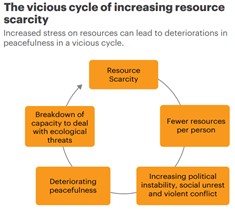
Major Findings of the Ecological Threat Report, 2021
- Conflict and ecological threats: The main finding from the ETR 2021 is that a cyclic relationship exists between ecological degradation and conflict. It is a vicious cycle, whereby degradation of resources leads to conflict, leading to further resource degradation.
- To reverse these cycles both the ecological environment and societal resilience need to improve, which requires a systemic approach.
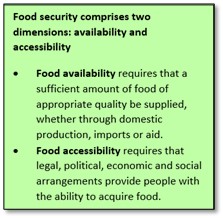
- Food Insecurity and Ecological threats: The number of malnourished people has been steadily rising since 2016. By 2050, the global demand for food is expected to increase by 50%.
- Due to lockdowns and border closures, COVID-19 has amplified food insecurity further and will likely have a long-lasting negative impact on world hunger due to stagnant economic growth.
- The ETR reveals that by 2040 over 5.4 billion people will live in countries facing extreme water stress.
- Food Security and Conflict: In 2020, there were at least 19 countries in which conflict was the main driver of acute food insecurity.
- While food insecurity can result from violence, conflict and political instability, it can also be a trigger to and stressor of social tensions, leading to further conflict
- Ecological threat and migration: The ETR has found that more than 1.26 billion people live in 30 hotspot countries, suffering from both extreme ecological risk and low levels of resilience.
- These countries are least likely to be able to mitigate and adapt to new ecological threats, which is likely to cause mass displacement.

- Attitudes towards climate change: Just 3 and 35.1 per cent of the populations of China and India, the two countries with the largest populations and the first and third largest carbon dioxide emitters, perceive climate change to be a major threat over the next 20 years.
- Resilience at Risk: A country, if it is met with a sufficiently severe shock or a sequence of shocks, may turn into a low resilient hotspot. This could lower its Positive Peace level and leave it less equipped to deal with future shocks.
- Resilience provides a country with the capacity to cope with ecological shocks, minimising their negative impact on the population and economic structure. Secondly, it facilitates the recovery or rebuild of the socio-economic system in the aftermath of an ecological shock.

Policy Recommendations for Building ecological resilience
This report proposes a number of policy recommendations to improve the efficiency of interventions and break the vicious cycles that exist in many parts of the world. Three of the key recommendations were:

Conclusion: Ecological threats will continue to create humanitarian emergencies and will likely increase without a sustained effort to reverse the current trend. Ecological threats are becoming more pronounced and affecting more people than ever. Building resilience to these threats will increasingly become more important and will require substantial investment now and into the future.
Question: Discuss the reasons for rise in ecological threats to the world. What can be steps taken to build ecological resilience?
Sources:
Cosmic Reef
This is the image is of the Cosmic Reef and it comprises two different nebulae. Nicknamed Cosmic reef because it resembles the undersea world. The first nebula, with a hue of red and blue against a black backdrop dotted with sparkling lights, is a vast star-forming region in the Large Magellanic Cloud, a satellite galaxy of the Milky Way. Together with the second nebula seen in blue, the entire structure is called the Cosmic Reef. This Cosmic Reef spans some 600 light-years and it is some 160,000 light-years away from Earth, as per NASA.

Source:
Tight Oil
- Context: Cairn Oil & Gas has announced that it will partner with US-based Halliburton to start shale exploration in the Lower Barmer Hill formation, Western Rajasthan.
- Tight Oil, also known as “shale oil,” is processed into gasoline, diesel, and jet fuels just like conventional oil.
- Tight oil is a type of oil found in impermeable shale and limestone rock It is found in smaller batches and in depths greater than conventional crude deposits.
- However, its extraction requires creation of fractures in oil and gas rich shale to release hydrocarbons through a process called hydraulic fracking which requires significantly more energy (thereby more emissions/more pollution) than conventional drilling techniques.
- Other impacts of tight oil include significant water, air, and noise pollution around drilling sites.
- Russia and the US are among the largest shale oil producers in the world and with respect to India, there is no large-scale commercial production of shale oil and gas.
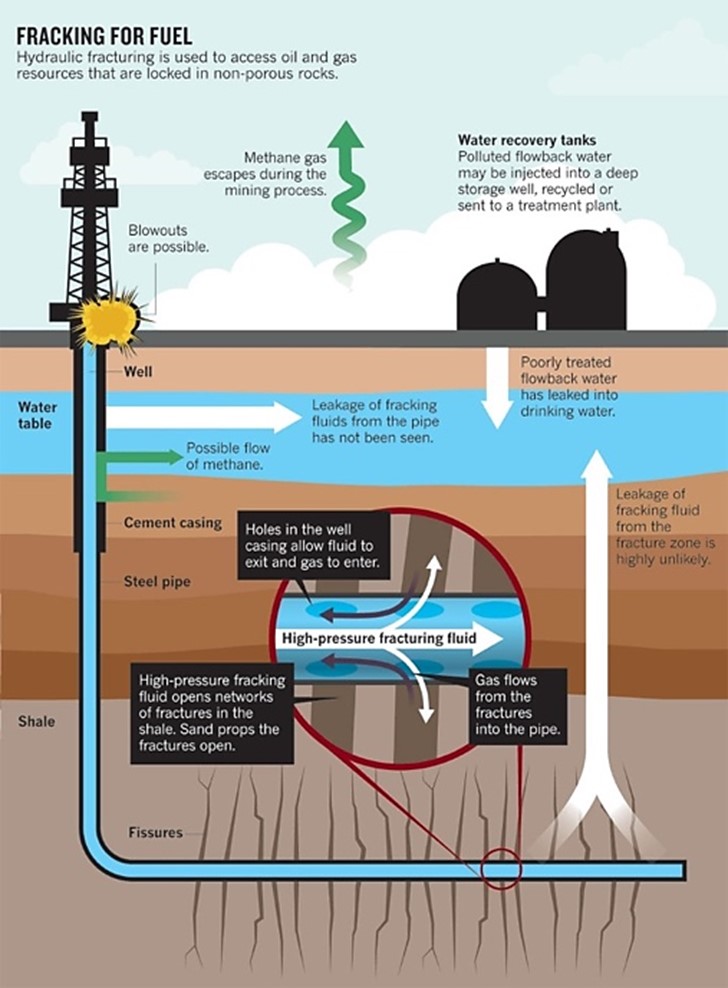
Source:
Image Source:
Sabz Burj
- Context: An intricate artwork on the ceiling of Sabz Burj has been discovered during its conservation and restoration project.
- Sabz Burj is a 22-metre high octagonal monument located to the west of Humayun’s Tomb and serves as a gateway to the world heritage site.
- It is counted among the earliest Mughal-era buildings built in the 1530s and is believed to have belonged to an important nobleman.
- It demonstrates Timurid architectural style synonymous with Central Asia and is double-domed like Humayun’s Tomb.
- With the word “Sabz” in its name means “green”, the tomb is largely covered in turquoise blue tiles. The lotus finial atop the dome and the neck, however, consist of green tiles.
- The ceiling painting of the monument is found to have used real gold and lapis lazuli.
- Lapis lazuli, is a deep-blue metamorphic rock used as a semi-precious stone that has been prized for its intense colour.

Source:
- Four Years On: Sabz Burj restoration complete, rare painting on ceiling discovered
- Delhi: Sabz Burj gets a new lease of life
Image Source:
INS Visakhapatnam
- Context: Made-in-India INS Visakhapatnam has been commissioned into Indian Navy at the Naval Dockyard in Mumbai.
- It is the first indigenously built stealth guided-missile destroyer ship, under the Make in India initiative.
- It measures 163m in length, 17m in breadth with a displacement of 7,400 tonnes and can be regarded as one of the most potent warships to have been constructed in India.
- The ship is propelled by four powerful Gas Turbines, in a Combined Gas and Gas (COGAG) configuration, capable of achieving speeds in excess of 30 knots.
- It is packed with sophisticated state-of-the-art weapons and sensors such as Surface-to-Surface missile and Surface-to-Air missiles.
- It is fitted with a modern surveillance radar which provides target data to the gunnery weapon systems of the ship.
- The ship is equipped to fight under Nuclear, Biological and Chemical (NBC) warfare

Source:
- Made-in-India INS Visakhapatnam commissioned into Indian Navy
- INS Visakhapatnam commissioned into Indian Navy in presence of Rajnath Singh
Image Source:
UNESCO Executive Board
- Context: India has been re-elected to the UNESCO Executive Board for the 2021-25 term.
- The UNESCO Executive Board is one of the three constitutional organs of the United Nations' agency (the others being the General Conference and the Secretariat).
- It is elected by the General Conference and it examines the programme of work for the organisation and corresponding budget estimates submitted to it by the Director-General.
- It ensures the overall management of UNESCO and derives its responsibilities primarily from the Constitution and from rules laid down by the General Conference.
- It consists of 58 member-states each with a four-year term of office.

Source:
Image Source:
Reforming the Fertilizer Sector: TH
Essence: There have been many attempts to reform the fertilizer sector in India. One area of concern in subsidy on fertilizers especially uncontrolled increase in subsidies on urea. The rise in fertilizer subsidy is directly proportional to upsurge in the price of energy, international prices of urea and other fertilizers and India’s dependence on imports. Also, subsidies have been demanded on organic fertilizers and biofertilizers due to their environmental benefits over chemical fertilizers. When the government tries to compensate the price rise in form of subsidy it leads to serious fiscal challenges. There are also inter-state disparities in fertilizer subsidy which is highly biased towards urea. Four key areas for reforming fertilizer sectors are required: self-reliance, price rationalization for urea, having alternate source of nutrition for plants and fertilizer efficiency through need-based use.
Why to read this article?
- To understand the areas of concern to be addressed in order to reform fertilizer sector especially the issue of rising fertilizer subsidy.
- To know a few steps through which a successful fertilizer policy can be achieved.
Sources:
WTO: Ensuring that sustainable development and trade are equitable: HT
Essence: The editorial creates the context for a debate on environment protection at WTO ministerial with the draft of document “environmentally sustainable trade” prepared by the developed world. The rationale provided by these countries is that both “sustainable development” and “environment” find a place in the first paragraph of the agreement establishing the WTO. The developed nations are proposing carbon tax and these measures seem to be proxy protectionist measures in the name of protecting the environment.
However, UNFCCC arrangements do not prescribe a “one-size-fits-all” approach to emission reductions. It talks about common but differentiated responsibilities and respective capabilities (CBDR-RC), which is a recognition of the differentiated accountability of countries for the climate crisis. Any discussion on “sustainable development” would necessarily need to address these aspects.
Why should read this article?
- To understand the world politics around environmentally sustainable trade.
- To understand the proxy protectionist measures taken by the developed nations in the name of protecting environment.
Source:
To insure or to assure the farmer?: HBL
Essence: The article evaluates the performance of Pradhan Mantri Fasal Bima Yojana along with providing the reason for states opting out of the program. Delay in settlement of claims, non-coverage of post-harvest losses form some of the many reasons for the states to opt out of it. With the rise in global temperatures, farmers are now more vulnerable to climate change. Due to this, there is a need to stabilize their incomes.
For providing it a model where insurance and assurance co exist can be devised. While large farmers can be provided insurance, small and marginal farmers, sharecroppers/tenants can be provided assurance. Last but not the least with Central support, implementation should be left to the States.
Why you should read this article?
- To help understand the performance of Pradhan Mantri Fasal Bima Yojana.
- To understand the steps that could be taken to stabilize the income of the farmers.
- The above article is important part of GS-3 economy syllabus and holds importance as the scheme has recently completed 5 years.
Source:
Ray of Hope for the Destitute: Auto Raja
Background
- Intentions play a vital role not just on the person who has it but also for the ones towards whom it is.
- An auto-rickshaw driver Thomas Raja, from Bengaluru has shown that his pious intention is a ray of hope for many destitude.
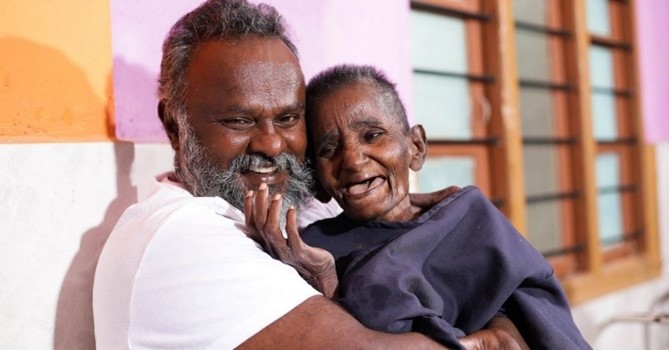
How a criminal turned social worker became a ray of hope of many?
- Thomas Raja, a wandering errant, who was involved in theft and petty crimes, also stole from his father due to which he was thrown out his home.
- While serving as a prisoner, he could put things into perspective and decided to lead an honest live.
- While he started his livelihood as an auto-rickshaw driver he often witnessed the homeless and destitute down the lane.
- He decided to help them by renting a place and naming it Home of Hope, where 13 persons were rehabilitated.
- Currently, he has rehabilitated about 19000 persons, along with fighting for their rights.
Quote:
“If everyone had the madness for doing good, there wouldn't be any misery in the world.”
― Abhijit Naskar,
Source:
Share the article
Get Latest Updates on Offers, Event dates, and free Mentorship sessions.

Get in touch with our Expert Academic Counsellors 👋
FAQs
UPSC Daily Current Affairs focuses on learning current events on a daily basis. An aspirant needs to study regular and updated information about current events, news, and relevant topics that are important for UPSC aspirants. It covers national and international affairs, government policies, socio-economic issues, science and technology advancements, and more.
UPSC Daily Current Affairs provides aspirants with a concise and comprehensive overview of the latest happenings and developments across various fields. It helps aspirants stay updated with current affairs and provides them with valuable insights and analysis, which are essential for answering questions in the UPSC examinations. It enhances their knowledge, analytical skills, and ability to connect current affairs with the UPSC syllabus.
UPSC Daily Current Affairs covers a wide range of topics, including politics, economics, science and technology, environment, social issues, governance, international relations, and more. It offers news summaries, in-depth analyses, editorials, opinion pieces, and relevant study materials. It also provides practice questions and quizzes to help aspirants test their understanding of current affairs.
Edukemy's UPSC Daily Current Affairs can be accessed through:
- UPSC Daily Current Affairs can be accessed through Current Affairs tab at the top of the Main Page of Edukemy.
- Edukemy Mobile app: The Daily Current Affairs can also be access through Edukemy Mobile App.
- Social media: Follow Edukemy’s official social media accounts or pages that provide UPSC Daily Current Affairs updates, including Facebook, Twitter, or Telegram channels.

